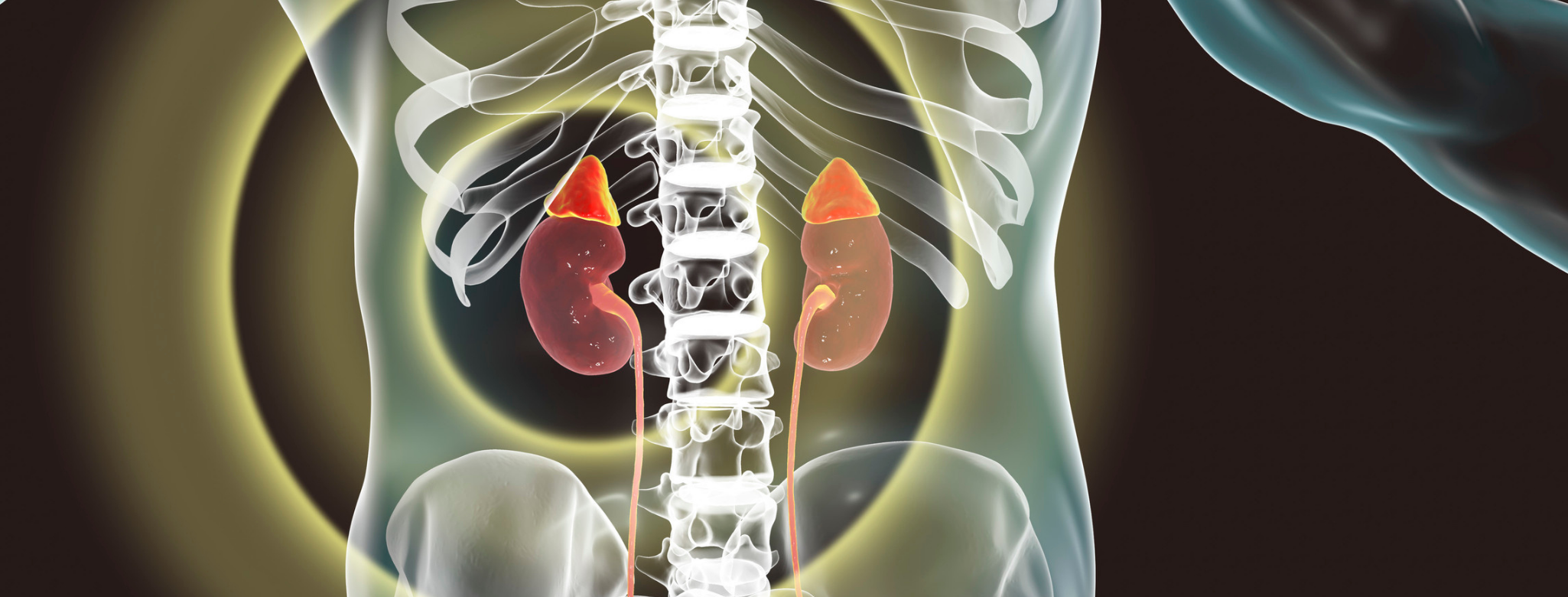What is MEN2 (formerly MEN2a)?
MEN2 (Multiple Endocrine Neoplasia type 2) is a rare genetic disorder caused by mutations in the RET gene, which plays a critical role in cell signaling and growth. There are three types of tumor that can occur in MEN2. These occur in the butterfly-shaped thyroid gland in the neck, the parathyroid glands that lie close to or within the thyroid, and in the adrenal glands that sit on top of each kidney. Although most of the tumors are benign (not cancer), the tumor in the thyroid gland is always cancerous (medullary thyroid cancer or MTC). Each type of tumor may occur alone and independently of MEN.
Blood and urine tests for hormone levels as well as scans of the neck and abdominal area are all used to check for tumors. If a tumor is found an operation may be needed to remove either just the tumor itself or the whole of the affected gland. This is necessary in early childhood in the case of medullary thyroid cancer.
-
Living with MEN2
What Is the RET Gene?
The RET gene (rearranged during transfection) plays a crucial role in nerve cell development and regulates signals that control cell growth. Mutations in RET can cause uncontrolled cell division, leading to tumors in the endocrine glands. These mutations are inherited in an autosomal dominant pattern, meaning a person only needs to inherit one faulty copy of the gene to develop MEN2. Identifying a RET mutation in a family allows for early screening and interventions, including surgery, to prevent or manage disease progression.
MEN1 v. MEN2
MEN1 and MEN2 are both types of Multiple Endocrine Neoplasia (MEN), but they affect different glands and result from mutations in different genes.
- MEN1 is caused by mutations in the MEN1 gene and primarily leads to tumors in the parathyroid glands, pancreas, and pituitary gland. It is more strongly associated with pancreatic neuroendocrine tumors and high calcium levels.
- MEN2 is caused by mutations in the RET gene and is primarily associated with medullary thyroid cancer (MTC), pheochromocytomas, and parathyroid tumors. It was previously divided into two subcategories (MEN2A & MEN2B) and has a subtype called FMTC (Familial Medullary Thyroid Carcinoma).
While both conditions are inherited in an autosomal dominant pattern (meaning only one parent with the mutation can pass it on), their screening, management, and tumor risks differ. Genetic testing helps distinguish between MEN1 and MEN2, allowing for targeted surveillance and preventive treatments.
What Are the Symptoms of MEN2?
Regardless of which part of the body is affected by MEN2, all symptoms primarily result from abnormal hormone production and tumor growth. Since MEN2 most commonly causes medullary thyroid cancer (MTC), people with the syndrome commonly experience a lump in the neck, hoarseness, or difficulty swallowing. Many individuals also develop tumors in the adrenal glands that lead to high blood pressure, headaches, sweating, and rapid heart rate. Let’s take a look at how MEN2 can affect different parts of the endocrine system.
Thyroid Cancer in MEN2
The butterfly-shaped thyroid gland is found at the base of the throat in the front of the neck. Almost 10 out of 10 (100%) of MEN2 patients will develop medullary thyroid cancer (MTC) by the time they are aged 40. The thyroid cancer or the pre-cancerous hyperplasia, may be found using blood tests to measure levels of calcitonin. Treatment involves an operation to remove the thyroid gland and the nearby lymph nodes (total thyroidectomy).
After the operation lifelong medication called levothyroxine needs to be taken. If calcitonin is still detected after the operation, further operations and other therapies are used to control it. MTC is usually slow growing and may often be managed effectively in this way without symptoms for many years. Children identified as having MEN2 are offered a thyroidectomy before the age of 5. Parathyroid glands are sometimes unavoidably removed at the same time as the thyroid gland (see parathyroids).
MEN2 & Familial Medullary Thyroid Carcinoma (FMTC)
As we noted above, MEN2 is caused by mutations in the RET gene, whose role is to provide instructions for growing cells. Some RET mutations cause a subtype of MEN2 known as Familial Medullary Thyroid Carcinoma (FMTC). FMTC is a variant of MEN2 where medullary thyroid cancer (MTC) is the primary or only feature, with minimal or no involvement of other endocrine glands.
-
 X-Ray Illustration of the Parathyroid Glands
X-Ray Illustration of the Parathyroid Glands
Parathyroid Glands and PTH
These small glands lie just next to or are sometimes embedded within the butterfly-shaped thyroid gland in the neck. Less than 1 in 4 (25%) of MEN2a patients will develop a parathyroid tumor called an adenoma. These tumors release large amounts of parathyroid hormone (PTH) and so can be easily found using blood and urine tests. Some symptoms of an untreated parathyroid tumor include irritability, ulcers, kidney stones, pancreatitis, bone fractures, osteoporosis, tiredness, muscle or bone pain, indigestion, poor memory and constipation. However most patients will have very few of these symptoms particularly when diagnosed and treated early on.
At the moment, the recommended treatment for parathyroid tumors is a relatively small operation to remove all of the glands, and involves only a few days in hospital. Medicines to control parathyroid hormone is available where surgery is not possible. After parathyroid glands are removed, patients may have to take a Vitamin D capsule to help the body absorb calcium.
How Severe Is Hypercalcemia in MEN2?
Hypercalcemia, or elevated calcium levels in the blood, is a common complication of MEN2, particularly in those with parathyroid adenomas or hyperparathyroidism. The severity of hypercalcemia varies, and some people may experience no symptoms or very mild ones. In severe hypercalcemia, individuals can face fatigue, kidney stones, bone pain, nausea, vomiting, and confusion. If left untreated, it can lead to kidney damage and heart problems. However, with early diagnosis and proper management, usually parathyroid surgery to remove overactive glands, hypercalcemia can often be controlled.
-
 X-Ray Illustration of the Adrenal Glands
X-Ray Illustration of the Adrenal Glands
Adrenal Glands and Phaeochromocytomas
The body’s two adrenal glands are normally each about the size of a whole walnut and sit just on top of the kidneys. A tumor of the inner part of the adrenal gland is called a phaeochromocytoma (fee-o-cromo-sy-toma) and is almost always benign (not cancerous) in MEN. Phaeochromocytomas may grow for many years without causing severe symptoms but can be activated by events such as childbirth or surgery. Symptoms are varied and may include all or some of the following: sudden migraine-like headaches, palpitations, breathlessness, excessive sweating, high (or rarely low) blood pressure (constant or off- and-on), trembling, tiredness, depression, anxiety, and nausea with or without vomiting.
These growths may be detected using blood and urine tests as well as several different types of scan. Treatment involves an operation to remove the gland and tumor. A period of medicine before surgery is necessary to control the unstable blood pressure. If both adrenal glands are removed, lifelong steroid replacement therapy is necessary.
Can MEN2 Cause Pancreatitis?
While pancreatitis is not a common feature of MEN2, some individuals with the syndrome may develop pancreatic involvement due to mutations affecting hormone-producing cells. In rare cases, MEN2-related tumors, such as pheochromocytomas or parathyroid adenomas, can disrupt calcium balance or hormone levels, indirectly increasing the risk of pancreatitis. However, MEN1—a separate condition—has a stronger link to pancreatic tumors. If a person with MEN2 experiences symptoms of pancreatitis, further evaluation is needed to determine the cause.
When Should Someone Be Screened for MEN2?
If you have a family history of MEN2 or a known RET gene mutation, then screening for Multiple Endocrine Neoplasia (MEN) is highly recommended, particularly in childhood. Because the associated mutations of the RET gene are dominant, children of an affected parent have a 50% chance of inheriting the mutation. Fortunately, genetic testing can identify MEN2 even before symptoms develop. Screening is also advised for people with medullary thyroid cancer (MTC), pheochromocytomas, or hyperparathyroidism, as these tumors may indicate an underlying MEN2 diagnosis.
What Is the Life Expectancy for Someone With MEN2?
With early diagnosis and proper management, life expectancy for individuals with MEN2 can be near normal. The most important factor for MEN2 patients in determining prognosis is early detection and treatment of medullary thyroid cancer (MTC) and other associated tumors. Preventive thyroid removal (prophylactic thyroidectomy) in childhood significantly reduces the risk of MTC-related complications. That’s why in families with a known history of MEN2 or RET mutations, early childhood screening is vital.
Author: Jo Grey, AMEND CEO, with the help of the AMEND Medical Advisory Team. Updated by John Metzcar.
Further Reading
-
MEN2a Patient Information Book

Patient Stories
Click here to read patient stories about MEN2A
-
My Story Template

Want to write your own story but don't know where to start? Use our handy template for inspiration! Just scan and send by email or pop it in the post.
Click here to download the template